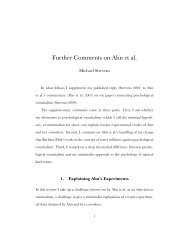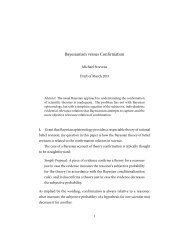The Essentialist Aspect of Naive Theories - Michael Strevens
The Essentialist Aspect of Naive Theories - Michael Strevens
The Essentialist Aspect of Naive Theories - Michael Strevens
You also want an ePaper? Increase the reach of your titles
YUMPU automatically turns print PDFs into web optimized ePapers that Google loves.
Pure essentialism may be represented in pictorial form as a diagram imputing<br />
a certain structure to a naive theory. A fragment <strong>of</strong> naive biology,<br />
according to the essentialist hypothesis, has the structure shown in figure 1.<br />
Ferocity<br />
Being a tiger<br />
Essence <strong>of</strong><br />
tigerhood<br />
Stripes<br />
Figure 1: A pure essentialist theory<br />
In this figure, the octagonal box represents a kind-defining essence, the rectangular<br />
box the kind it defines, and the rounded boxes characteristic observable<br />
properties <strong>of</strong> that kind. <strong>The</strong> arrows represent causation. <strong>The</strong> dashed<br />
line represents a semantic, or defining, link: an animal is considered to be<br />
a tiger—that is, to be a member <strong>of</strong> the natural kind “tiger”—if and only<br />
if it has the essence <strong>of</strong> tigerhood. I should emphasize that on the pure hypothesis,<br />
the naive essentialist may have no opinion as to what essences actually<br />
are. <strong>The</strong>ir essentialism consists in their thinking that essences exist—<br />
whatever they may be—and that they play the category-defining and causal<br />
roles illustrated in figure 1.<br />
1.2 Statistical Essentialism<br />
Another version <strong>of</strong> the essentialist hypothesis appears in Medin and Ortony<br />
(1989). Medin and Ortony agree with the pure essentialist hypothesis that,<br />
although humans may not know anything about a category’s essence, they<br />
believe that there is such an essence. 4 <strong>The</strong> authors say that in such a situation,<br />
the thinker’s theory has an essence placeholder. 5 This placeholder is<br />
eventually replaced by a representation <strong>of</strong> the nature <strong>of</strong> the essence, if such<br />
knowledge is acquired.<br />
4. “ . . . we are claiming . . . that people find it natural to assume, or act as though, concepts<br />
have essences” (Medin & Ortony, 1989, 184).<br />
5. “ . . . we propose that the knowledge representations people have for concepts may<br />
contain what might be called an essence placeholder” (p. 184).<br />
4






